Honeysuckle Hekrota - description and characteristics
Honeysuckle is one of the most unpretentious plants that can grow in almost all regions of our country. The most popular is edible honeysuckle with healthy and tasty fruits. However, gardeners also grow an ornamental variety of this plant. Its berries are inedible, but have an attractive appearance. One of these crops is Hekrota honeysuckle.
Absolutely all parts of this plant are decorative. These are reddish shoots, green-blue leaves, large bright flowers, and spherical shiny red berries. What varieties of Hekrota honeysuckle exist and how to grow them on your site - read on.
Varieties of honeysuckle Hekrota
Hekrota's honeysuckle is curly decorative bush. It is a hybrid obtained by crossing evergreen and American honeysuckle. The Hekrota group includes several varieties.
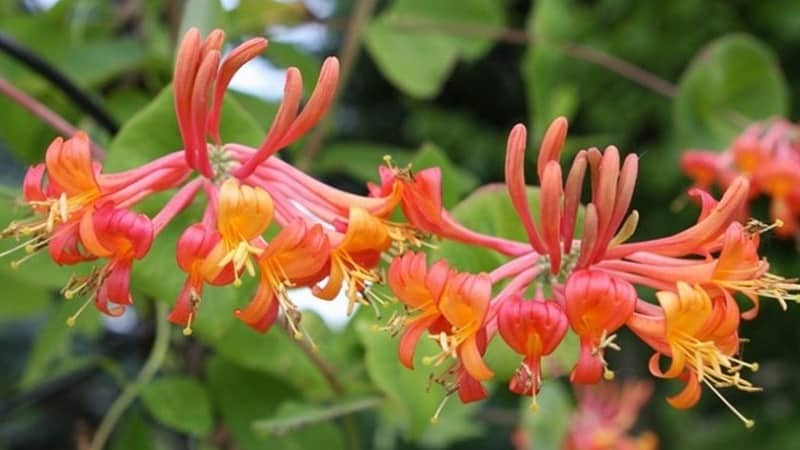
Eat common characteristics that unite them:
- Bush. Tall, weaving. The branches are thin and flexible. Young shoots are reddish in color; with age they acquire a brown tint. Mature plant height on average reaches 2-4 m (depending on formation). Hekrota grows throughout its life, increasing annually by 30-50 cm. The width of the crown varies between 2-4 m. The lifespan of the shrub reaches 50 years.
- Leaves. Widely eleptic shape. They reach 8-10 cm in length. The color is green with a bluish tint. In autumn they acquire a yellowish tint.
- Flowers. Collected in large inflorescences.The length varies between 3-5 cm. Each flower has two petals, with the top one being several times wider than the bottom one and having a wavy edge. The flowers are two-colored, the shades depend on the variety. Flowering continues from June to September.
- Fruit. Round, shiny fruits. Poisonous. The diameter varies between 5-7 mm. The color depends on the variety.
Goldflame
Honeysuckle Gecrota Goldflame (Lonicera Heckrottii) or Hekrotta Goldflame is one of the most popular varieties of climbing ornamental plants. It is highly resistant to pests and diseases. This is a climbing vine.
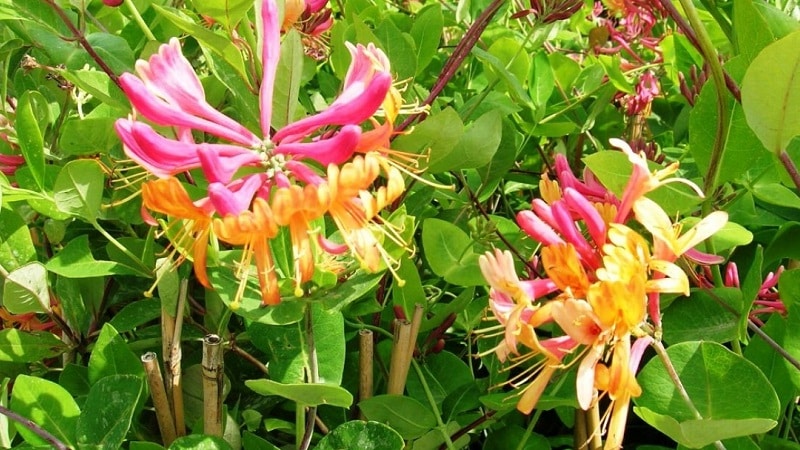
Leaves of a characteristic bluish-green hue. They have jagged edges and reach 10 cm in length.
Two-color flowers. The outside is bright pink and the inside is bright orange. Large (about 5 cm in length). They have a strong sweetish aroma.
The berries are small, round, red. Ripen in late summer or autumn.
The variety has a number of advantages. Among them:
- a large amount of foliage and flowers on the bush;
- significant annual increase in shoot length (more than 50 cm);
- long flowering;
- large flowers and inflorescences;
- the presence of immunity to infections and pests;
- fast rooting.
Frost resistance of honeysuckle Hekrota Goldflame is average. The plant is able to survive winter in the central regions only under cover.
Heckrott's Goldflame variety also has disadvantages:
- poisonous fruits;
- demands on watering;
- demands on soil composition;
- tendency to expose branches with age;
- long wait for the first flowering.
The first flowering and fruiting is expected in 3-4 years after the plant has rooted.
American Beauty
Honeysuckle American Beauty has characteristics that are slightly different from the previous variety. It is characterized by increased winter hardiness. It is a climbing shrub.
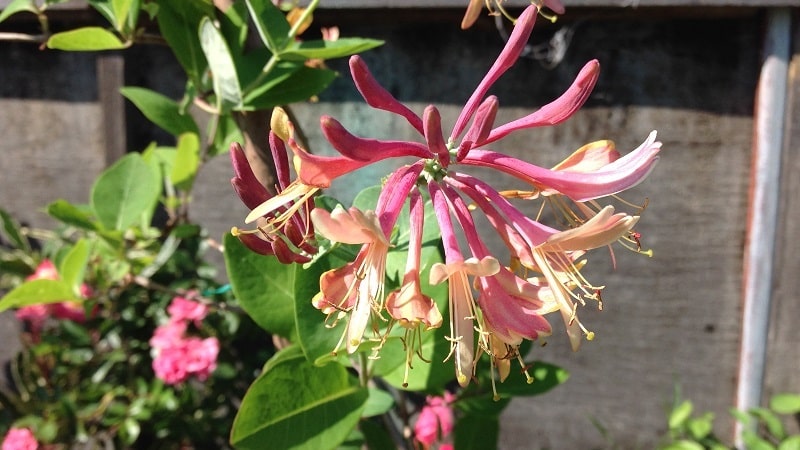
The flowers are cream or pale yellow on the outside and pink on the inside.. The inflorescences are more compact than those of Goldflame honeysuckle. The upper petal of the flower is much wider than the lower one. The aroma is weak.
The berries are small, bright orange in color. Formed at the end of summer.
Advantages:
- high winter hardiness;
- abundant flowering and fruiting;
- large flowers (some specimens reach 8 cm in length);
- fast rooting.
The main disadvantage is the high maintenance requirements. The variety requires frequent watering and fertilizing.
Variegata
Honeysuckle Variegata looks significantly different from other Hekrota varieties. It looks decorative even when it is not blooming.
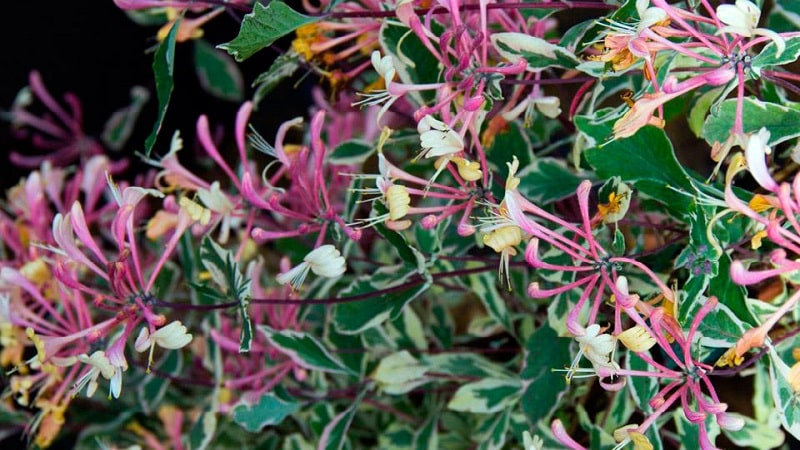
The leaves of this variety are two-colored. They are bluish-green in the center and white on the edges. They have a characteristic elliptical shape.
Flowers are purple on the outside and white or cream on the inside.. Collected in large inflorescences. The berries are red. The aroma is vanilla-jasmine, rich.
Like all varieties of Hekrota Variegata is distinguished by its demands on humidity and soil composition. At the same time, it is immune to infections and is rarely affected by pests.
This is interesting! The evergreen Variegata variety was developed in Japan.
Features of agricultural technology
Hekrota is somewhat more demanding to care forthan other types of honeysuckle.
Planting process
The crop propagates only vegetatively. Only in this case does it retain varietal characteristics.
During vegetative propagation use one of three methods:
- Cuttings. This is the most popular method, allowing you to obtain a large amount of planting material.Healthy, well-bending branches without signs of disease or damage are cut into pieces 10-15 cm long. Each piece must have at least three living buds. The cuttings are treated with a weak solution of potassium permanganate and a growth stimulant (for example, Heteroauxin), and then planted in containers with a fertile substrate (peat and sand). The soil is loosened and watered; the soil should always be moist. After the planting material takes root (this is evidenced by the awakened buds), they begin to feed it, for example, “Nitrophoska”. Planted in the ground the next year. Cuttings are carried out in early spring.
- Reproduction by layering. With the onset of stable heat, the branches located near the ground are bent to the ground, fixed with a bracket and covered with earth. During the summer, the cuttings are watered and fed. After the branch takes root and shoots, it is separated from the mother plant and divided into parts. Planted in a permanent place in the fall, before the onset of cold weather.
- Dividing the bush. The root system is carefully dug up, trying to cause minimal damage to the plant. The bush is divided into parts and planted.
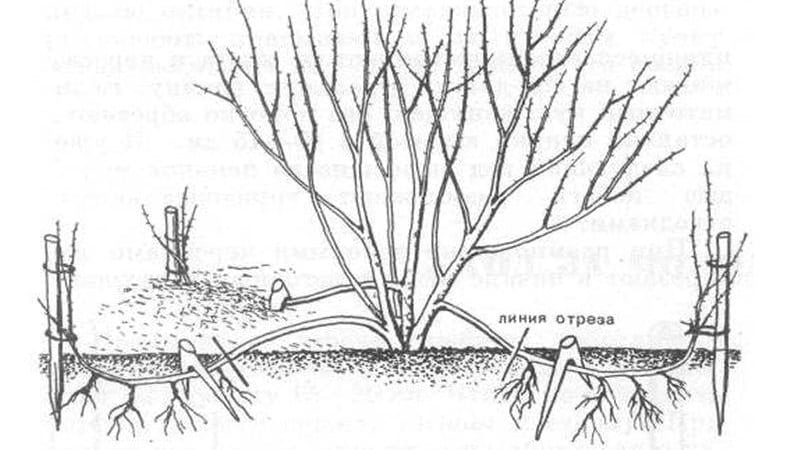
Ready seedlings are planted in a permanent place in early spring or in autumn, before the onset of cold weather. In order for the plant to quickly take root and not get sick, it is important to choose suitable planting material:
- Root system. Closed or open type. The roots should be moist when cut. It is important that there are no traces of rot and a large number of dry areas.
- Size and age. Preference is given to seedlings 1-2 years old. The height should not be less than 40 cm. It is desirable to have several branches.
- Escapes. Should be flexible, not dry.If you scrape off the bark with your fingernail, green tissue is revealed underneath. It is important to have at least three living buds on each branch. If you press lightly on them with your finger, they should not fall off.
The planting material should be free of traces of diseases and pests, stains, and damage.. Peeling is not considered a sign of poor quality. This is a feature of honeysuckle.
Note! Hekrota cuttings and seedlings take root quickly.
Hekrota is demanding on soil composition. Loose, nutritious, slightly acidic soils are preferred. Groundwater should be located no closer than 1 m to the surface. It is not recommended to plant honeysuckle near currants and gooseberries.
Before planting honeysuckle in open ground, the soil is dug up and cleared of weeds.. If necessary, reduce its acidity with lime or ash, then water it with a hot solution of copper sulfate.
For Gekrota choose a well-lit but wind-protected area of the garden. In the shade, its flowering becomes less abundant.
With honeysuckle planting Even a novice gardener can handle it. The main thing is to follow the instructions:
- Dig a hole with a diameter and depth of 40 cm. The soil removed from it is mixed with 5 kg of humus or rotted manure, 1 kg of ash, 25 g of superphosphate, 20 g of potassium sulfate.
- A 5 cm layer of drainage is poured into the bottom of the hole. A mound of nutritious soil mixture is formed on top.
- The roots of the seedling are soaked for 2 hours in a light pink solution of potassium permanganate. Then they are soaked for 12 hours in a root formation stimulator, for example, “Kornevin”. In the case of a closed root system, this step is skipped.
- The seedling is placed in the hole in the center. The roots are evenly distributed around the earthen mound.
- The hole is covered with earth, compacting it.The seedling is watered, using at least two buckets of warm, settled water.
- If necessary, add more soil. The soil around the honeysuckle is mulched with rotted straw, hay or humus.
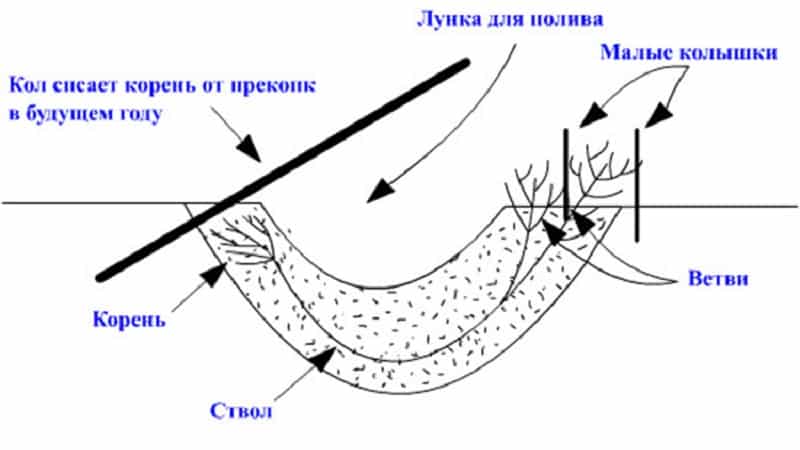
How to care for decorative honeysuckle Hekrota
In order for Hekrota honeysuckle to develop correctly and bloom profusely, it is important to provide it with proper care.. Compared to other varieties of honeysuckle, it is quite demanding.
Note! Hekrota occupies an important place in garden design. It is recommended to plant it near fences, gazebos or building facades. It makes these buildings more aesthetically pleasing by weaving them.
Watering and fertilizing
Hekrota is demanding when it comes to watering. With a lack of moisture, its leaves begin to curl, the flowers become small, and the flowering becomes scarce.
In hot, dry summers, honeysuckle is watered every day.. Water is poured both at the root and the entire plant is sprayed with it. It is better to do this early in the morning or at sunset, when the sun is inactive.
For irrigation use warm, settled water. Cold liquid will cause the roots to rot. If the summer turns out to be rainy, the soil is moistened every 2-3 days. Spraying is carried out on all days without precipitation.
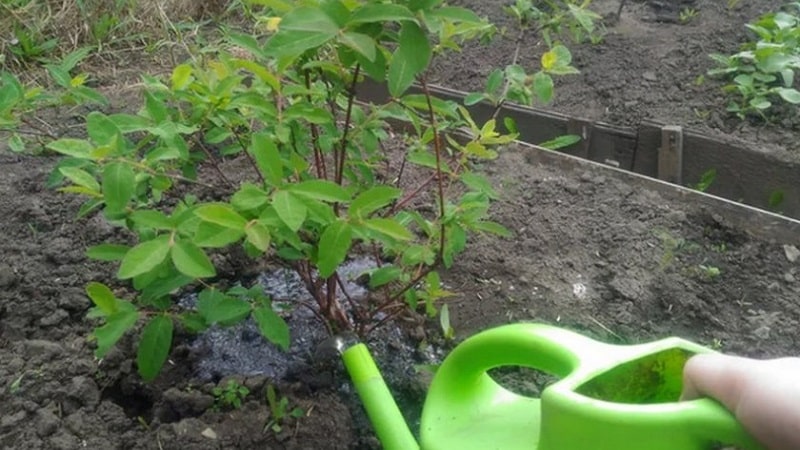
After each watering and precipitation, the soil is loosened, destroying the earthen crust. Otherwise, the water will begin to stagnate and the roots will rot. During the loosening process, weeds are removed. Weeds often cause honeysuckle to become infected with bacteria and pests.
Fertilizing begins two years after planting. honeysuckle Before this, the plant has enough nutrients that were added to the soil.
The first fertilizing is applied in early spring, immediately after the soil thaws.The plant is watered with complex mineral fertilizer or a solution prepared from 30 g of superphosphate. 20 g of potassium fertilizers and 15 g of potassium nitrate.
Before flowering begins Honeysuckle is watered with Kemira or organic fertilizers. For example, a solution of rotted manure is often used. diluted with water in a ratio of 1:10 with the addition of a glass of ash per bucket.
Midsummer apply foliar fertilizing. The spray mixture is prepared from urea (0.1%), superphosphate (1%), potassium chloride (0.5%).
In the fall before preparing the plant for winter add 2 tbsp under the bush. ash and 1 kg of rotted manure. Fertilizers are buried under the bush.
Important! The day before fertilizing, the soil must be moistened.
Trimming and shaping
Honeysuckle care involves regular pruning. There are three types of this procedure:
- Formative. Used to give the plant the desired shape. Hekrota is formed in the form of a bush or vine. Most gardeners prefer to leave five powerful trunks, removing all the weak ones. If the plant is planted near a support, then its height is adjusted according to the height of the support. Be sure to remove all old branches that produce few leaves and inflorescences.
- Sanitary. Conducted annually. Remove damaged shoots. Branches with traces of disease and pest damage, cracked bark.
- Rejuvenating. Carry out when the abundance of flowering decreases and a large number of old branches form. The plant is shortened by 2-3 cm. All old branches are removed. This stimulates the formation of young shoots.
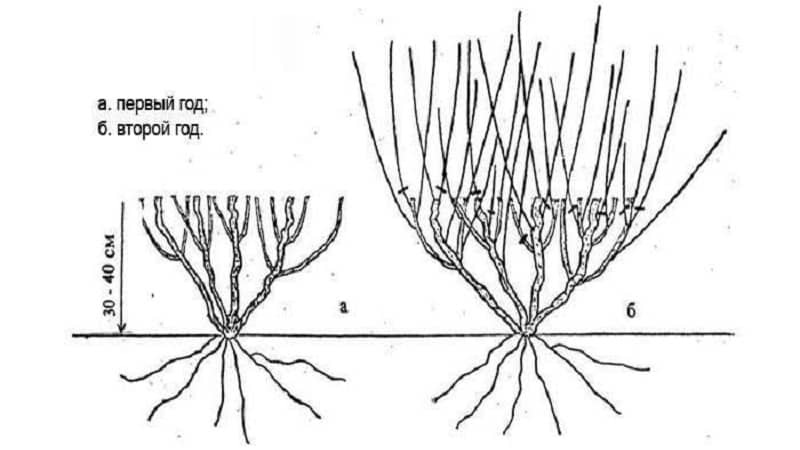
Pruning is carried out in early spring, before the buds wake up, or in the fall, before frost sets in.. The cut areas must be treated with garden varnish to prevent the gum from leaking out.
Other decorative types of honeysuckle:
Diseases and pests
Gecrota's honeysuckle is immune to most diseases, characteristic of this culture. Reviews say that she is rarely affected pests. Despite this, it is important to follow the rules of prevention:
- Trimming. Every year they carry out sanitary pruning and thin out the crown.
- The right neighborhood. It is not recommended to plant honeysuckle near currants, gooseberries and coniferous trees.
- Autumn cleaning. In autumn, fallen leaves, broken branches and other plant debris are removed from the site.
- Disinfection. Be sure to disinfect planting material, soil, and garden tools.
Wintering
Despite the fact that Hekrota honeysuckle is considered a frost-resistant plant, without proper preparation in the northern and central regions she won't survive the winter. To protect the plant from frostbite, it is removed from its support and covered with as high a layer of mulch as possible.
In winter, honeysuckle is covered with snow. If the winter is not snowy, the bush is covered with spunbond.
Conclusion
The description of Hekrota's honeysuckle will please both experienced and novice gardeners. This is an ornamental plant with beautiful evergreen leaves and large bright inflorescences. It is characterized by long flowering, during which it emits a pleasant aroma. Despite the fact that the berries of this honeysuckle are poisonous, they decorate the plant.
Hekrota is more demanding of care than many other types of honeysuckle. However, following the basic rules of agricultural technology, even a novice gardener can cope with its cultivation.